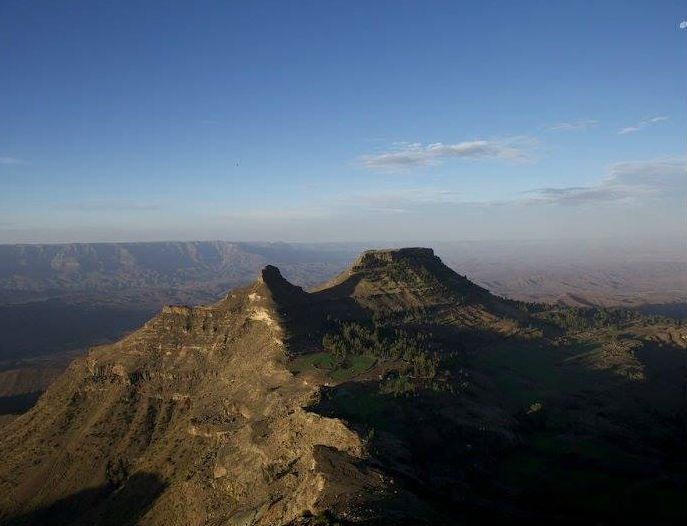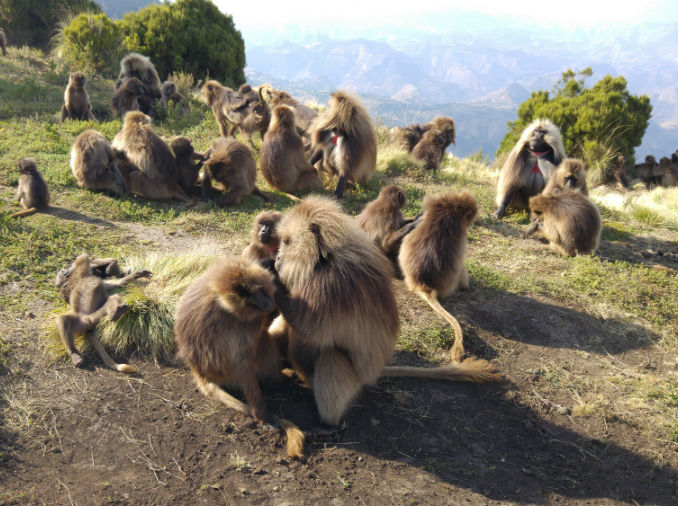
Lalibela is surrounded by a very escarpment landscape with great scenery and beautiful villages. In Ethiopia there are 25 mountain peaks, rising to an altitude of more than 4000 meters, allowing the country to earn the nickname of the roof of Africa and ensuring spectacular sensory for the visitor.
Ethiopia is a varied and diverse country; at its core, an age old culture of farmers who have been plowing their fields with ox-drawn plows for a few thousand years. Their life is intrinsically linked to the agricultural seasons and the ancient Ethiopian Orthodox calendar with its saints’ days and festivals punctuating their life.
Local communities near Lalibela invite you to accept their hospitality during your trek through their age old lands. Set in the dramatic landscape of the highlands of northern Ethiopia, with
basalt cliffs, Gelada baboon and birds of prey soaring on the thermals, your visit in Lasta mountains around Lalibela will be the highlight of your trip to Ethiopia. Visit our services page to see different options of exploring this unique area.
Mount Abune Yosef (4300m)
The third highest peak in Ethiopia, Abune Yosef Massif offers visitors stunning views and wildlife viewing opportunities. During the treks and around Abune Yosef, visitors can see an impressive array of flora and faunaincluding giant Lobelia, troops of Gelada baboons, and the rare Ethiopian wolf.
Located north of Lalibela, the Afromontane environment offers a perfect complement to the cultural and historical experience of the Lalibela rock hewn churches. Treks in Abune Yosef bring visitors to over 4,300 meters and are not for the faint of heart. However, those that make the climb find the views and experience well worth it. Visit our itinerary page to arrange how many days to spend at mount Abune Yosef.


Flora
While many of the high plains has been converted into farmland over the past 50 years the slopes of the mountain ranges are still covered by natural forest, changing composition with altitude, the unique Afromontane vegetation formations are the main attraction of the area.
The Abune Yose area is made up of diverse vegetation types included bush land, woodlands, mountain dry forests, and afroalpine grassland.
Flora
While many of the high plains has been converted into farmland over the past 50 years the slopes of the mountain ranges are still covered by natural forest, changing composition with altitude, the unique Afromontane vegetation formations are the main attraction of the area.
The Abune Yose area is made up of diverse vegetation types included bush land, woodlands, mountain dry forests, and afroalpine grassland.

Flora
While many of the high plains has been converted into farmland over the past 50 years the slopes of the mountain ranges are still covered by natural forest, changing composition with altitude, the unique Afromontane vegetation formations are the main attraction of the area.
The Abune Yose area is made up of diverse vegetation types included bush land, woodlands, mountain dry forests, and afroalpine grassland.

Fuana
Mammals: There are 43 known species of mammals on the Abune Yosef Massif. Of the 32 species of Abyssinian endemic mammals (endemic to Ethiopia and Eritrea) seven can be found in Abune Yosef. The most spectacular of these are the Ethiopian wolf and the Gelada baboon. Other species to look out for include the Golden Jackal, Hyena, Caracal, Leopard, Rock Hyrax, Duiker, Klipspringer and Starck Hare.
Birds: Of the 860 species of birds found in Ethiopia, over 220 have been identified on the Abune Yosef Massif. The Abune Yosef area is one of the most important bird areas in the country. The Abune Yosef mountains also attract a few pairs of Golden Eagles.


